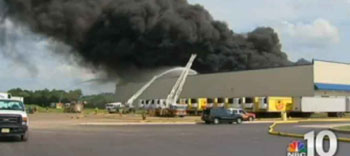With all the benefits of solar and the great gains we’re making on installations in the US, there’s an issue the industry needs to address – how a roof covered with solar panels may become a problem in the case of a fire.
A 7000-solar panel array on the roof of a 300,000 square foot New Jersey distribution center has made fighting a massive fire at the building difficult, reports NBC Philadelphia.
New Jersey’s acting fire marshall went as far to say, "We may very well not be able to save buildings that have alternative energy," William Kramer, told The Star Ledger.
The fire, which may have started on the roof, destroyed the building and solar panels could be partly to blame. Firefighters were ordered to stay away from the roof because of electrocution concerns.
"With all that power and energy up there, I can’t jeopardize a guy’s life for that," Fire Chief Ron Holt told NBC. He was also concerned the roof would collapse so firefighters worked from afar, simply spraying the building with water and foam.

"Those panels, as long as there’s any kind of light present, whether it’s daylight or it’s electronic lamp light, will generate electricity," Ken Willette of the nonprofit National Fire Protection Association, told NBC.
The maximum voltage of a solar panel system is quite low at 600 volts, but if momentary contact can produce continuous shock, thermal injury and ventricular fibrillation, according to the NJ Division of Fire Safety, reports The Star Ledger.
Unlike other sources of electricity, solar energy can’t just be turned off. Researchers at Underwriters Lab recommend throwing a tarp over the panels that blocks light, but that’s if firefighters can safely access the roof.
The Fire Protection Research Foundation, in a 2010 report says, "The inability to de-energize individual photovoltaic panels exposed to sunlight cannot be overemphasized. It is absolutely imperative that emergency responders always treat the systems and all its components as energized. This includes after the emergency event is stabilized, as the system will continue to be energized while exposed to sunlight, possibly with damaged system components that could present serious shock hazards or even cause a rekindling of a fire."
When solar panels cover a roof, firefighters also can make ventilation holes in the roof – used to put out the fire.
Willette says codes need to be developed for solar installations that take care of this problem. Perhaps training for firefighters would help too.
"The new paradigm is firefighters might encounter building systems they have little or no knowledge of," he told NBC. "It used to be homes and commercial buildings had roofs and walls and heating and ventilation systems that the fire service was used to dealing with…modern technology, both in building construction and these other alternative energy systems, have changed that."
Ken Johnson, vice president for communications of Solar Energy Industries Association, told Star Ledger, "There are hundreds of thousands of solar systems nationwide and only a handful have been linked to fires since 1996. By contrast, there have been tens of thousands of fires related to toasters, microwaves, TVs, washers and dryers, computers and entertainment equipment.
"The solar energy industry takes safety very seriously. We are working closely with firefighters and organizations all across the country on the development of enhanced codes and standards for solar installations. We also intend to ramp up our educational efforts aimed at all first responders … A review of product standards, building codes and first responder training, especially for firefighters, is an important place to start."

For buildings where there is considered to be a risk to fire crews, I would suggest the following solution.
Use DC optimisers on each solar panel.
These carry out maximum power point tracking on a panel by panel basis and have safety features built in. When the array is switched off at the inverter, the panels are likewise pretty much switched off – In the case of Solar Edge, each panel puts out 1 Volt when disconnected from the string inverter so any string stays at a safe voltage of 20 volts or less.
Combine this with a fire service database of solar installations notifying fire crews when this technology has been applied, and prominently displayed safety information on site and the crews will know whether there is an electrical risk from any installation.
In regards to the need to get onto the roof to cut into the building for fire fighting purposed, regulations for large buildings could include set aside walkways allowing arrays to be installed without limiting fire fighting options.
I thought Chief Holt’s comments are not fundamentally accurate. Many monitoring instruments as well as disconnect switches could be installed to isolate the energy generated from the solar panels. It is comments as such that damage a whole industry. Chief Holt’s should inquire about solutions (which there are many) instead of adding fuel(pun intended)and damaging the illustrious solar energy movement.
Somebody can make money with this. Spray the panels with something that blocks the light and cannot be washed away with water only by a chemical later on. I would guess this is going to raze the fire insurance rates for buildings with solar.